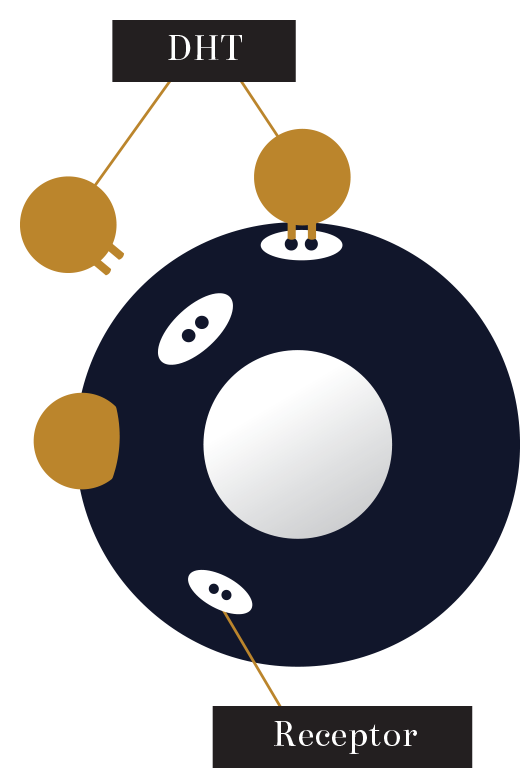Hair
Did you know that on average between 90,000 and 150,000 hairs grow on your head? Hair grows on average 0.3 millimeters per day and consists of the protein keratin. A hair grows from a hair root bag situated just under the skin and that, together with a sebaceous gland, forms a hair follicle.
Hair cycle
Each hair has its own cycle. A growth phase, a transition phase and a rest phase. Hair continues to grow for an average of 2 to 6 years and then goes into a transitional phase for 2 to 3 weeks and then rests for 3 months.
When the hair root bag changes from rest to growth, the old hair is pushed away by the new growing hair. 85% of the hairs on the head are in the growth phase. The hair root bag can only go through these phases 20 to 30 times in a lifetime. Because of this cycle we lose about 50 to 100 hairs every day. Nothing to worry about.
You do not have to be surprised if you find a serious pluck of hair in the shower. If you lose a lot more hair per day, we speak of hair loss.
Hair loss
Hair loss is genetically determined in more than 95 percent of men and women. This form of baldness is called Alopecia androgenetica, which is an expensive word for 'classic male baldness'. As the description suggests, it is caused by male hormones (androgens). Confusing, because both men and women have to deal with Alopecia androgenetica! However, women also have male hormones (androgens) in addition to female hormones (estrogens). The amount of male hormones in the blood is often too low before menopause to cause visible hair loss. After the menopause, the amount of female hormones decrease, so that there are proportionally more male hormones in the blood that accelerate the process of hair loss, unfortunately resulting in less and thinning hair, also among the ladies.
Factors of hair loss
The three main factors that determine male hair loss are:
- Hereditary factors (genes);
- Hormones;
- Age.
How does this work?
Each hair root bag has a receptor. This is a place where only 1 or a few particles fit exactly. Just think of a lock on the door, often only one key fits on the lock.
With hair loss, testosterone (a male hormone, an androgen) is the major culprit. A slightly different form of testosterone (Dihydrotestosterone), DHT, sits on the receptor and makes a connection. Your genetic predisposition (your genes) determine how sensitive the receptor of the hair root bag is for DHT. When the DHT sits on its receptor, it ensures that a hair can grow less (a shorter growth phase), making the hair shorter, thinner and finer. Ultimately, bald spots can thus arise.

Cell of hair root bag
Other Causes of hair loss
Hair loss has several causes and is not always 'the normal male pattern of hair loss'. Often you are completely unaware of this and you have not noticed anything special about the scalp or the abnormal way in which you lose your hair. In these cases, signaling is worth gold! Stopping and slowing down the underlying condition then has our priority. This way we can try not to lose the precious hairs any further. After all, we do not have to reconstruct every hair that is not lost.
Alopecia Areata
If one or more bare circular spots occur, we call this Alopecia Areata. This can completely recover and leave no scars. This condition is caused by a disturbance in the immune system that causes the hair to be attacked during the growth phase, with the result that the hairs fall out.
Cicatriciële alopecie
A complicated collective term for disorders of the scalp where the hair root bags are destroyed and severe scarring is visible. This is created through a response from the OWN immune system. It is very difficult to treat these syndromes, of which the cause is still unclear.
Other causes
Scars caused by injuries, radiation, thermal or chemical burns can also cause baldness. We can, however, often treat these scars very nicely.
Required age for treatments
We can treat children from the age of about 6 years, dependending on the extent to which the child can sit or lie still. The maximum age depends on the state of health and medication use. It is especially important that no blood thinners are used.
Magnitude of the problem
Hair loss not only leads to practical problems, such as the styling of the hair, but it also affects self-confidence. It can make you feel less attractive. It often seems so obvious to have hair at a young age, that it can have a huge impact at the moment it starts to fall out. You not only lose your hair, but also a piece of your identity.
The number of people who are affected by it are immense. For example, 30% of 30-year-old men are bald, 50% of 50-year-old men are bald and 70% of 80-year-old men are bald. These numbers are different for women. Only 3-6% of the women under 30 are confronted with this. However, the percentage is increasing steadily, with 40% of women at 80 years old having to deal with this problem.
